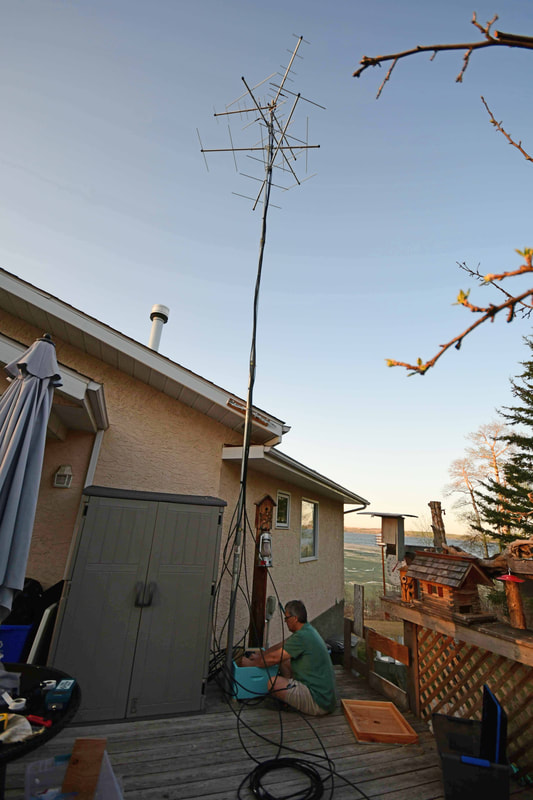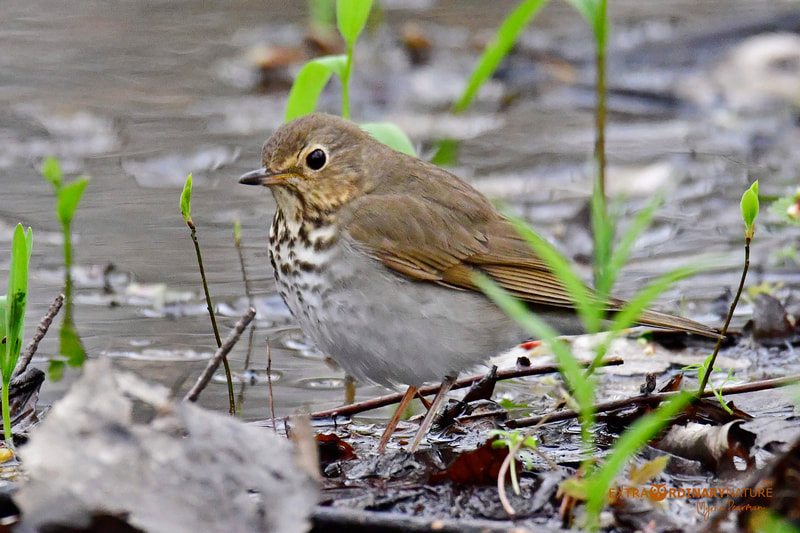Motus Project

One of the highlights near the end of my career at EBF was to oversee the installation of Alberta’s first MOTUS station in 2020.
MOTUS is an international collaborative research network that uses coordinated automated radio telemetry to track migrating animals. Special nanotags are affixed to the animals and receiving stations, placed across the landscape, detect them as they pass by. Under ideal conditions, birds bearing nanotags can be detected within a 15-km radius of the station!
The system, which was not as streamlined in 2019/2020 as it is now, was designed and installed by a local naturalist and technology enthusiast.
The EBF system was taken down shortly after my departure. Almost three years later, I was approached by another keen engineer, Mark Cundict of Red Deer, who offered to install a station on our Sylvan Lake property. The system went live in May and we have waited expectantly since then for a “hit.”
Finally, success! On October 4th, two Northern Saw-whet Owls – who’d each received their tags (“deployed”) at the Beaverhill Bird Observatory east of Edmonton – passed through. One had been deployed on September 22; the other on September 28.
Interestingly, they both passed through on the same evening. One flew by without stopping at around 8:55 PM while the other one arrived just before midnight and hung around the area for about 10 minutes.
Check out the MOTUS website to find out more about this remarkable technology, which is shedding light on the miracle of bird migration (https://motus.org/).
Mark will be giving a short presentation about MOTUS and this project at the October 26th meeting of the Red Deer River Naturalists. The meeting will be held at Kerry Wood Nature Centre and will start at 7:00 PM.
We occasionally see Northern Saw-whet Owls resting in our trees during fall migration. This image shown here was taken in our yard a few years ago. A flock of scolding chickadees alerted us to its presence. It opened its eyes for a picture and then fell back asleep.
MOTUS is an international collaborative research network that uses coordinated automated radio telemetry to track migrating animals. Special nanotags are affixed to the animals and receiving stations, placed across the landscape, detect them as they pass by. Under ideal conditions, birds bearing nanotags can be detected within a 15-km radius of the station!
The system, which was not as streamlined in 2019/2020 as it is now, was designed and installed by a local naturalist and technology enthusiast.
The EBF system was taken down shortly after my departure. Almost three years later, I was approached by another keen engineer, Mark Cundict of Red Deer, who offered to install a station on our Sylvan Lake property. The system went live in May and we have waited expectantly since then for a “hit.”
Finally, success! On October 4th, two Northern Saw-whet Owls – who’d each received their tags (“deployed”) at the Beaverhill Bird Observatory east of Edmonton – passed through. One had been deployed on September 22; the other on September 28.
Interestingly, they both passed through on the same evening. One flew by without stopping at around 8:55 PM while the other one arrived just before midnight and hung around the area for about 10 minutes.
Check out the MOTUS website to find out more about this remarkable technology, which is shedding light on the miracle of bird migration (https://motus.org/).
Mark will be giving a short presentation about MOTUS and this project at the October 26th meeting of the Red Deer River Naturalists. The meeting will be held at Kerry Wood Nature Centre and will start at 7:00 PM.
We occasionally see Northern Saw-whet Owls resting in our trees during fall migration. This image shown here was taken in our yard a few years ago. A flock of scolding chickadees alerted us to its presence. It opened its eyes for a picture and then fell back asleep.
Another Motus Story - 2024
I had a Motus receiver installed near my residence at Sylvan Lake, AB in May 2023 thanks to the expertise and generosity of Mark and Joanne Cundict of Red Deer. The first detections were of two Northern Saw-whet Owls, both of which had been affixed with radio transmitters in late September at the Beaverhill Bird Observatory east of Edmonton. Both moved through my yard on the evening of October 4, 2023.
A few weeks ago, Mark noticed that Motus had added another detection of interest to us to their public website. Both my receiver and his in Red Deer(!) had picked up, in September, a Swainson’s Thrush (SWTH). Motus detections are automatically uploaded if the bird remains within receiver range for at least three minutes. This particular thrush was detected for just under three minutes, so the detection was likely noticed by researchers reviewing their project data and then posted to the Motus site.
“Our” Swainson’s Thrush (51769/80209) was banded on August 28, 2023 by the BC Interior Thrushes #280 project, a joint research project of the Canadian Wildlife Service and Texas A & M University. This team is deploying transmitters as part of their “Investigation of migratory tendencies of SWTH in a sub-species hybrid zone in the Interior of British Columbia.” They deployed transmitters on a total of 599 Swainson’s Thrushes at various stations within their study region. #80209 was tagged at 50.220153, -122.884084, at a site just off the Sea-to-Sky Highway near the Shadow Lake Interpretive Forest, north of Whistler, BC.
After being fitted with its transmitter, the bird headed in a northeast direction, perhaps following river valleys, and passed by my Sylvan Lake tower at 5:30 AM on the morning of September 13, having traveled 651 km. It continued eastward and was detected by Mark and Joanne’s tower in Red Deer a mere 20 minutes later, covering a distance of 27 km. It then headed southeast where it was detected by a receiver located at The Mountain Retreat and Learning Centre near Highlands, North Carolina, on October 7, having traveled a distance of 3,075 km. The most exciting part of this story is that it then traveled south for an additional 2,700 km, arriving at Parc Nacional Santa Rosa, Costa Rica, on November 18, 2023.
More information about Motus can be found at motus.org.
I would like to thank Mark and Joanne Cundict for generously installing my Sylvan Lake tower. Mark, now officially retired, has become an in-demand Motus maven!



















